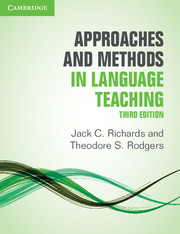Book contents
- Frontmatter
- Contents
- Acknowledgments
- Introduction to the third edition
- I Major trends in twentieth-century language teaching
- II Current approaches and methods
- III Alternative twentieth-century approaches and methods
- IV The teaching and learning environment
- Appendix: Comparison of approaches and methods
- Author index
- Subject index
11 - The Lexical Approach
Published online by Cambridge University Press: 08 April 2022
- Frontmatter
- Contents
- Acknowledgments
- Introduction to the third edition
- I Major trends in twentieth-century language teaching
- II Current approaches and methods
- III Alternative twentieth-century approaches and methods
- IV The teaching and learning environment
- Appendix: Comparison of approaches and methods
- Author index
- Subject index
Summary
Introduction
We have seen throughout this book that central to an approach or method in language teaching is a view of the nature of language, and this shapes teaching goals, the type of sylla-bus that is adopted, and the emphasis given in classroom teaching. The syllabuses that were reflected in language courses in the first half of the twentieth century viewed vocabulary (particularly single-word lexical items) and grammar as the building blocks of language. Changed views of language that emerged with the concept of communicative competence prompted a search for alternative syllabus conceptions (see Chapter 5). One type of syl-labus and teaching proposal that appeared in the 1990s and that has been refined and developed since that time was termed the Lexical Approach (Lewis 1993, 1997, 2000a; Boers and Lindstromberg 2009). A lexical approach in language teaching refers to one derived from the belief that the building blocks of language learning and communication are not grammar, functions, notions, or some other unit of planning and teaching but lexis, that is, words and particularly multi-word combinations. The Lexical Approach reflects a belief in the centrality of the lexicon to language structure, second language learning, and language use, and in particular to multi-word lexical units or “chunks” that are learned and used as single items. While early discussions of the Lexical Approach (e.g., Lewis 1993) emphasized the important role of vocabulary in general in language learning, subsequent discussion of this approach has focused mainly on the role of multi-word units, or “chunks,” which is the focus taken in this chapter. The role of vocabulary in language teaching per se is not central to current formulations of the Lexical Approach but is dealt with extensively in the litera-ture (e.g., Bogaards and Laufer-Dvorkin 2004; Schmitt 2008; Meara 2009; Nation 2013).
Schmitt (n.d.) comments, clarifying that chunks may consist of either collocations, a term that refers to the regular occurrence together of words, or fixed phrases:
The Lexical Approach can be summarized in a few words: language consists not of traditional grammar and vocabulary but often of multi-word prefabricated chunks. The lexical approach is a way of analysing and teaching language based on the idea that it is made up of lexical units rather than grammatical structures. The units are words and chunks formed by collocations and fixed phrases.
- Type
- Chapter
- Information
- Approaches and Methods in Language Teaching , pp. 215 - 229Publisher: Cambridge University PressPrint publication year: 2014

